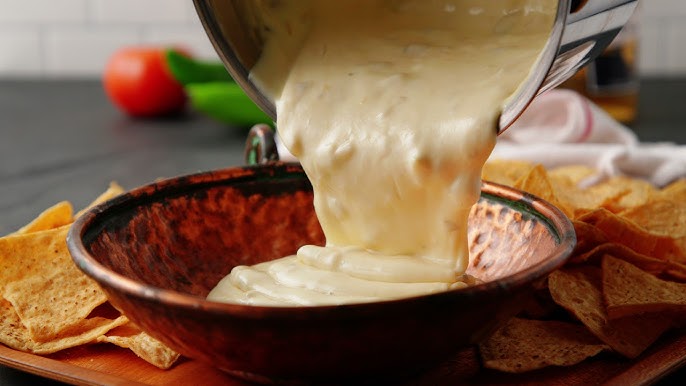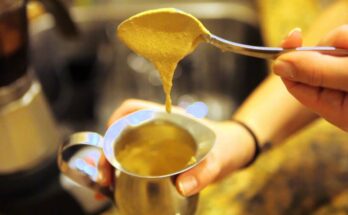Queso Blanco Recipe: There’s nothing quite like fresh, homemade cheese. And when it comes to simple, delicious cheeses, Queso Blanco is a crowd favorite. It’s mild, creamy, and versatile — the perfect addition to just about any dish. The best part? You don’t need any fancy equipment or hard-to-find ingredients.
This guide walks you through how to make it from scratch in your own kitchen with everyday ingredients.
Introduction to Queso Blanco
Queso Blanco, meaning “white cheese” in Spanish, is a fresh, unaged cheese that has roots in Latin American and Spanish cuisines. It’s known for its mild, milky flavor and crumbly yet creamy texture. Unlike cheeses that require complex aging processes, Queso Blanco is easy to make at home, often in less than an hour.
What makes Queso Blanco stand out is its simplicity. No rennet, no bacteria cultures — just milk and an acid like vinegar or lemon juice to create the curds. It’s a great cheese for beginners to try making because the process is straightforward and practically foolproof. Plus, it’s vegetarian-friendly because it doesn’t use animal-derived rennet.
You’ll often find Queso Blanco served crumbled over tacos, melted into dips, or eaten plain with a sprinkle of salt. Its versatility makes it a staple in many households, especially among fans of Mexican or Tex-Mex food.
Ingredients You’ll Need
Making Queso Blanco starts with just a few ingredients. Here’s what you’ll need:
Basic Ingredients
- 1 gallon of whole milk – Full-fat milk works best to achieve a creamy texture.
- 1/4 cup of vinegar or lemon juice – These acids help form the curds.
- 1 teaspoon of salt – To bring out the flavor.
Make sure to use fresh, high-quality milk. Ultra-pasteurized milk doesn’t work well because the protein structure is altered, making it difficult for curds to form. Always check the label on the milk carton before starting.
Optional Add-ins for Flavor Variation
- Herbs like chives or parsley for a fresh kick
- Crushed red pepper flakes for heat
- Minced garlic for a savory note
- Black pepper or paprika for extra depth
These aren’t necessary but can elevate your cheese to gourmet levels. You can stir them in after draining the curds for a flavored version.
Tools and Equipment Required
You don’t need a professional cheese-making kit to make Queso Blanco. Most of these tools are already in your kitchen.
Must-Have Kitchen Tools
- Large heavy-bottomed pot – To heat the milk evenly.
- Thermometer – For accurate temperature control.
- Wooden spoon or spatula – For gentle stirring.
- Cheesecloth or a clean kitchen towel – For draining the curds.
- Colander or strainer – To hold the cloth while draining.
- Large bowl – To catch the whey underneath the colander.
Optional Helpful Tools
- Slotted spoon – Makes it easier to scoop curds.
- Kitchen scale – If you’re measuring salt or herbs precisely.
Having these on hand will ensure a smooth cheese-making process. Still, the recipe is very forgiving, so if you don’t have everything listed, there’s usually a workaround.
Step-by-Step Queso Blanco Recipe
Now comes the fun part: actually making the cheese. Follow these detailed steps, and you’ll have a fresh batch of Queso Blanco ready in no time.
Step 1: Heating the Milk
Start by pouring the milk into your large pot. Set the heat to medium and slowly bring the milk to a temperature of 185°F to 190°F (85°C to 88°C). It’s important to stir the milk occasionally to prevent scorching on the bottom. A gentle stir every few minutes will do.
If you don’t have a thermometer, you can watch for visual clues. At around 185°F, the milk will begin to steam and form tiny bubbles along the edge of the pot, but it should never come to a full boil.
Patience is key here. Heating the milk too quickly can cause it to scald or behave unpredictably when the acid is added. Keep it slow and steady.
Once the milk has reached the desired temperature, remove the pot from heat. Now you’re ready for the magic moment — adding the acid!
Step 2: Adding the Acid
Slowly drizzle in your vinegar or lemon juice, one tablespoon at a time, while gently stirring the milk. Almost immediately, you’ll start to see the milk separating into curds (solid white clumps) and whey (the yellowish liquid).
Keep adding the acid until the curds are fully formed and the whey looks clear, not milky. This usually happens after about 1/4 cup of acid, but it can vary depending on the milk’s freshness and fat content.
Once the curds and whey have separated completely, stop stirring and let the mixture sit undisturbed for 10–15 minutes. This helps the curds firm up and makes them easier to handle during draining.
Step 3: Curds Formation and Separation
Once you’ve let the curds sit undisturbed for 10–15 minutes, it’s time to start the separation process. During this resting period, the acid continues to work its magic, encouraging more curdling and allowing the curds to firm up. What’s happening is that the proteins in the milk are coagulating, forming curds that trap fat and flavor, while the liquid whey is being pushed out.
Now, take a look at your pot. You should see distinct white clumps floating in a clear yellowish liquid. That’s a good sign. If the whey still looks cloudy, you might need to add a touch more acid and wait another 5 minutes.
This step is super satisfying — it feels like alchemy. If you’re using a slotted spoon, gently lift the curds to test their firmness. They should hold together but still feel soft to the touch, kind of like fresh mozzarella.
Try not to stir too much after the initial curdling. Too much agitation can break the curds into tiny pieces, making it harder to drain later and resulting in a crumbly, dry texture.
Step 4: Draining the Curds
Place your colander or strainer over a large bowl or the sink and line it with cheesecloth or a clean kitchen towel. Carefully ladle or pour the curds and whey into the lined colander.
Let gravity do the work here. Allow the curds to drain for about 10 to 30 minutes, depending on how moist or dry you want your final cheese. For a softer, spreadable texture, 10–15 minutes is enough. If you want a firmer, sliceable cheese, leave it to drain longer, and even press it gently with a spoon or small plate.
At this stage, you can sprinkle in salt and any optional add-ins like herbs or spices. Stir them in gently using a spoon or your hands. Salt not only enhances flavor but also acts as a natural preservative, extending the cheese’s shelf life.
Once you’re happy with the texture, gather the corners of the cloth and give it a light squeeze. You can shape it into a round or oval form for presentation or just leave it rustic — it’s all delicious either way.
Step 5: Seasoning and Storing
Your Queso Blanco is technically ready at this point — yes, that quickly! Now it’s time to decide how you want to season and store it.
First, taste a small piece. If it needs more salt, you can still gently fold some in. This cheese is a blank canvas, so you can add:
- Fresh chopped herbs (like cilantro, parsley, chives)
- Crushed peppercorns or red chili flakes
- Smoked paprika or ground cumin for a smoky twist
- Garlic or onion powder for extra umami
Once you’re satisfied with the flavor, shape the cheese as you like and transfer it to an airtight container. If it’s still a little moist, that’s okay — just line the container with a paper towel to absorb excess whey.
Store it in the refrigerator where it will stay fresh for up to 7 days. Over time, the texture may firm up a bit, but it will still taste amazing. You can even crumble leftovers into soups, salads, or tacos later in the week.
Tips for Perfect Queso Blanco
Want to become a Queso Blanco master? These tips will help you avoid common mistakes and refine your technique.
1. Don’t Overheat the Milk
Keeping the temperature between 185–190°F is crucial. If the milk boils, the curds may become rubbery or grainy.
2. Use Fresh Milk
Avoid ultra-pasteurized or shelf-stable milk. They’ve been processed too heavily for curds to form properly.
3. Go Easy on Stirring
Stirring too much, especially after curds start forming, can break them apart and give you a crumbly mess instead of smooth cheese.
4. Be Patient With Draining
If you want that perfectly creamy texture, resist the urge to rush the draining. Letting it sit longer makes the cheese firmer and less moist.
5. Customize Your Flavors
Try experimenting with herbs, spices, or even finely chopped jalapeños. Queso Blanco is like a blank white canvas waiting for your creative flavors.
6. Reuse the Whey
Don’t throw away the liquid whey! It’s rich in nutrients and can be used in smoothies, soups, or as a liquid for baking bread.
How to Use Queso Blanco in Dishes
So, now you’ve made this delightful cheese — what next? The possibilities are endless. Queso Blanco is incredibly versatile and works well in both savory and sweet dishes.
Everyday Uses
- Crumble it over tacos, enchiladas, or tostadas for a creamy contrast.
- Sprinkle on salads or grain bowls to add protein and texture.
- Melt it into quesadillas or grilled sandwiches.
- Mix into scrambled eggs or breakfast burritos.
Creative Ideas
- Stuff it into roasted peppers or tomatoes for a hearty vegetarian dish.
- Top it on pizza or flatbreads for a Mexican twist.
- Use as a dip base by mixing with cream and spices for a party favorite.
- Pair with fruits like mango or berries for a sweet-and-savory snack.
Queso Blanco doesn’t melt as smoothly as cheddar or mozzarella, but it softens beautifully and holds its shape, making it perfect for grilling or frying too.
Storage and Shelf Life
Once your Queso Blanco is ready, proper storage is key to maintaining its texture and flavor. Since it’s a fresh cheese and doesn’t contain preservatives or undergo aging, its shelf life is shorter than aged cheeses. But with a little care, you can keep it fresh and tasty for days.
Best Ways to Store Queso Blanco
Always store Queso Blanco in an airtight container in the refrigerator. You can line the container with parchment paper or a clean paper towel to absorb excess moisture, which helps preserve its texture and prevent spoilage.
If your cheese is lightly salted, it can last for up to 7 days. If heavily salted and well-drained, it might stay good for about 10 days. Make sure to check it daily for any signs of mold or sour smell — if you notice either, it’s time to toss it.
Can You Freeze It?
Technically, yes — but it’s not ideal. Freezing Queso Blanco changes its texture, making it more crumbly and dry. If you do freeze it, wrap it tightly in plastic wrap, then place it in a freezer-safe bag. Use it within 1 to 2 months, and expect a change in consistency. It’s still great for cooked dishes like casseroles, though!
Nutritional Information
Queso Blanco isn’t just tasty — it’s also a decent source of protein and calcium. Of course, like any dairy product, its nutritional profile depends heavily on the type of milk you use.
Typical Nutritional Breakdown (Per 1 oz/28g Serving):
| Nutrient | Amount |
|---|---|
| Calories | 80–100 |
| Protein | 5–7g |
| Total Fat | 6–8g |
| Saturated Fat | 4–5g |
| Carbohydrates | 1g or less |
| Sugar | 0g |
| Sodium | 150–250mg |
| Calcium | 10–15% DV |
Health Benefits
- High in protein – A good post-workout snack or meat substitute.
- Rich in calcium – Supports strong bones and teeth.
- Low in carbs – Great for low-carb or keto diets.
- Vegetarian-friendly – No rennet required.
However, because it’s made with whole milk, it can be high in saturated fat. For a lighter version, consider making it with 2% milk, though this may yield slightly less rich curds.
FAQs about Queso Blanco Recipe
1. Can I make Queso Blanco without a thermometer?
Yes! Look for signs like steam and tiny bubbles around the edges of the pot (but not boiling). Use visual and tactile cues like curd formation to guide you.
2. What’s the best milk to use?
Whole milk gives the best texture and flavor. Avoid ultra-pasteurized milk, which doesn’t curdle well.
3. Can I freeze Queso Blanco?
You can, but freezing changes the texture. It becomes more crumbly and is better used in cooked dishes after freezing.
4. How is it different from Queso Fresco?
Queso Blanco is made with acid (like vinegar or lemon juice), while Queso Fresco often uses rennet and may have a slightly different texture and taste.
5. Can I use lemon juice instead of vinegar?
Absolutely. Both work as coagulants, and lemon juice adds a subtle citrusy flavor. Use whichever you prefer or have on hand.
Conclusion
Queso Blanco is one of those delightful recipes that blend simplicity and satisfaction. With just milk, acid, and salt, you can create a fresh, creamy cheese that’s perfect for everything from tacos to salads to snacking. And the best part? You don’t need fancy tools or a culinary degree.
Whether you’re trying homemade cheese for the first time or looking for a quick and delicious cheese to add to your dishes, Queso Blanco is a must-try. It’s forgiving, adaptable, and always a hit at the table.
So next time you’ve got a gallon of milk and a few spare minutes, skip the store-bought cheese and whip up a batch of this homemade magic. You’ll be surprised at how easy and satisfying cheese-making can be.



